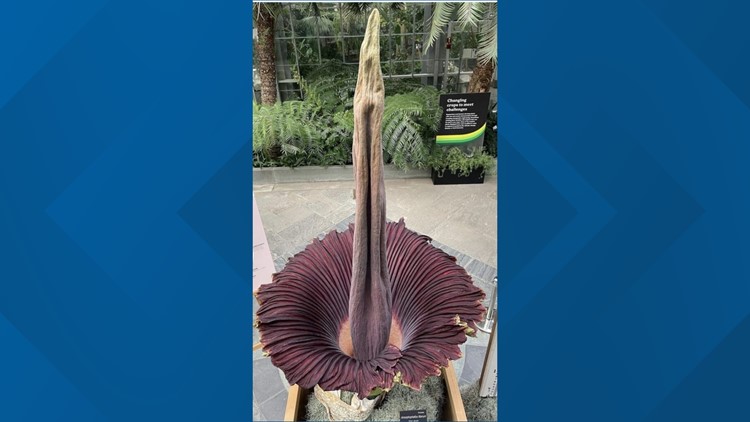WASHINGTON — Editor's note: The above video is from 2017.
Something stinky this way comes. A rare plant with an unusual stench has begun blooming at the U.S. Botanic Gardens. The gardens will have extended hours so people can get a look, and a sniff at the towering plant.
According to a post on social media, the corpse flower (aka Amorphophallus titanum) began opening Thursday night, three days ahead of its predicted bloom. At peak bloom, the flower gives off a powerful smell of rotting flesh, hence the name. It also gives off heat, which allows the putrid stench to travel farther. This combination of heat and smell efficiently lures corpse-attracted pollinators, such as carrion beetles and flies, from across long distances, the Botanic Garden said.
The 2022 corpse flower is about 97" tall. The bloom usually stands for about two or three days before collapsing.
To accommodate anyone who wants to see the bloom, the Botanic Gardens will stay open until 8 p.m. on Friday.
The corpse flower does not have an annual blooming cycle. The bloom emerges from, and energy is stored in, a huge underground stem called a "corm." The plant blooms only when sufficient energy is accumulated, making time between flowering unpredictable, spanning from a few years to more than a decade. It requires very special conditions, including warm day and night temperatures and high humidity, making botanic gardens well suited to support this strange plant outside of its natural range, experts at the Botanic Garden said.
The plant is native to the tropical rainforests of Sumatra, Indonesia, and first became known to science in 1878. In its natural habitat, the corpse flower can grow up to 12 feet tall. Public viewings of this unique plant have occurred a limited number of times in the United States. The U.S. Botanic Garden has displayed blooming corpse flowers in 2003, 2005, 2007, 2010, 2013, 2016, 2017 (three blooms), 2020 (two blooms), and 2021.
The corpse flower is listed as Endangered by the International Union for Conservation of Nature (IUCN), with an estimation of fewer than 1,000 individuals remaining in the wild.
Sign up for the Get Up DC newsletter: Your forecast. Your commute. Your news.
Sign up for the Capitol Breach email newsletter, delivering the latest breaking news and a roundup of the investigation into the Capitol Riots on January 6, 2021.



